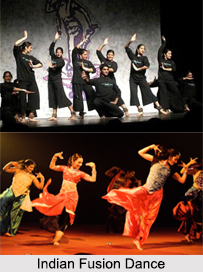 Indian Fusion Dance is an expression which is most intricate and is one of the most admired art forms in the country. The fusion dance style was created as a form that is adaptable to different types of music, different themes and different moods. The style started to give more scope for individual creativity, spontaneity and experimentation. Indian Fusion Dance thus became well accepted all over the country since its advent. Indian Fusion Dance is comparatively a new concept and it has seeped into several other realms of performing arts such as in music and theatre.
Indian Fusion Dance is an expression which is most intricate and is one of the most admired art forms in the country. The fusion dance style was created as a form that is adaptable to different types of music, different themes and different moods. The style started to give more scope for individual creativity, spontaneity and experimentation. Indian Fusion Dance thus became well accepted all over the country since its advent. Indian Fusion Dance is comparatively a new concept and it has seeped into several other realms of performing arts such as in music and theatre.
Evolution of Indian Fusion Dance
The classical-folk fusion dance is a perception of the 19th and 20th century. Indian Fusion Dance was first initiated in Bengal by the great Indian poet-philosopher Rabindranath Tagore. Dance suffered a lot of decline during the British rule and this motivated Tagore to revive the art form. As developed by the great poet, Indian Fusion Dance is a style that synthesizes together the elements from different Indian classical dances and folk dances. The century long development of dance as an art-form initiated fusion dance to be a popular vocation or entertaining mode. The classical-folk fusion style became accepted as it was enthusiastically appreciated by audiences in India and across the world. The classical-folk fusion was further expanded in the 1970s and 80s with the addition of elements of Western Ballet and modern dance.
Concept of Indian Fusion Dance
Fusion is an improvised dancing to any style of music that does not have a strictly defined dance aesthetic. Depending on the music and the dancers, fusion can mean creating a new dance style to unique music, or combining two or more established dance aesthetics into a single dance to reflect the sound of a song combining multiple influences. By finding the commonalities between various dance styles, or creating new movements, dancers can actively adapt and improvise their dance style to music of all influences.
Famous Exponents of Indian Fusion Dance
The grand history of tradition of Indian Fusion Dance traces down the contribution of Pandit Uday Shankar who is regarded as the “Father of Modern Danceâ€. He was one of the dancers who have taken Indian Fusion Dance to newer heights. This well-known dancer made “Indian Fusion Dance†a combination of classical and folk music as well as martial arts and received much encouragement from Rabindranath Tagore. In later years, Indian Fusion Dance saw progressive changes with the contribution of eminent fusion style with dancers like Mamata Shankar, Shanti Bose as well as Manjushri Chaki Sarkar. It is from the Indian Fusion Dance the genre of “Navanritya†or “New Dance†arrived in the panorama of dancing.




